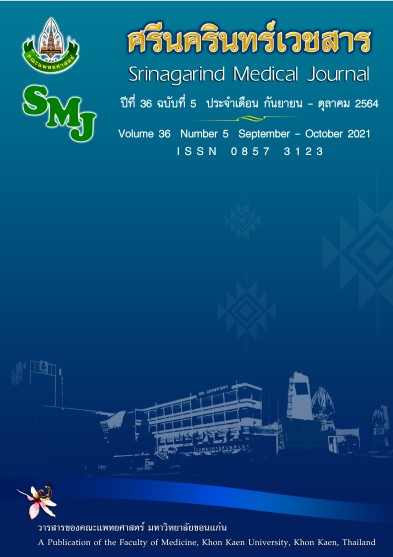Analysis of Hepatobiliary Phase of Gadoxetate Disodium Characteristics of Hepatocellular Carcinoma
Keywords:
Gadoxetate disodium; Hepatocellular carcinoma (HCC); Magnetic resonance imaging (MRI); Child-Puge; Alanine aminotransferase (ALT); Aspartate aminotransferase (AST); Alpha-fetoprotein (AFP)Abstract
Objective: To characterize the patterns of hepatocellular carcinoma (HCC) nodules and to determine the factors correlated with the hepatobiliary phase characteristics of the HCC nodules using gadoxetate disodium-enhanced hepatobiliary phase MRI.
Methods: A retrospective review of medical records and dynamic imaging using gadoxetate disodium-enhance MRI of patients with HCC at Srinagarind Hospital, Khon Kaen University, Thailand between April 2011 and October 2013 was performed. Demographic data were analyzed using descriptive statistics. Univariate logistic regressions were used to analyze the outcomes.
Results: Forty-five HCC were eligible for this study; the majority of the HCC patients (39 cases; 87.2%) had hypointensity of HCC nodules in the hepatobiliary phase. Of the 6 patients with hyperintense HCC nodules, 1 showed homogenous hyperintensity with hypointense rims and 5 showed hyperintensity with hypointense rims and focal defects in the hepatobiliary phase. Only ALT ³100 U/L was significantly associated with homogeneous hyperintensity and hyperintense rims with focal defects (p=0.008). There was no association between AFP level, size of the HCC nodules, and the Child-Puge classification with the pattern in the hepatobiliary phase.
Conclusion: In the gadoxetate disodium-enhanced hepatobiliary phase MRI images, the hypointense pattern was the most commonly seen in HCC nodules with typical vascular patterns. For HCC appearing as a hyperintense nodule in the hepatobiliary phase, a hypointense rim with a focal defect pattern could be observed. The patients with HCC and ALT ³100 U/L were associated with the hyperintense pattern of the hepatobiliary phase using gadoxetate disodium.
References
2. Bruix J, Sherman M. Management of hepatocellular carcinoma: an update. Hepatology 2011; 53: 1020-1022.
3. Leoni S, Piscaglia F, Golfieri R, Camaggi V, Vidili G, Pini P, et al. The impact of vascular and nonvascular findings on the noninvasive diagnosis of small hepatocellular carcinoma based on the EASL and AASLD criteria. Am J Gastroenterol 2010; 105: 599- 609.
4. Rhee H, Kim MJ, Park MS, Kim KA. Differentiation of early hepatocellular carcinoma from benign hepatocellular nodules on gadoxetic acid-enhanced MRI. Br J Radiol 2012; 85: e837-844.
5. Ichikawa T, Saito K, Yoshioka N, Tanimoto A, Gokan T, Takehara Y, et al. Detection and characterization of focal liver lesions: a Japanese phase III, multicenter comparison between gadoxetic acid disodium-enhanced magnetic resonance imaging and contrast-enhanced computed tomography predominantly in patients with hepatocellular carcinoma and chronic liver disease. Invest Radiol 2010; 45: 133-141.
6. Ahn SS, Kim MJ, Lim JS, Hong HS, Chung YE, Choi JY. Added value of gadoxetic acid-enhanced hepatobiliary phase MR imaging in the diagnosis of hepatocellular carcinoma. Radiology 2010; 255: 459-466.
7. Kogita S, Imai Y, Okada M, Kim T, Onishi H, Takamura M, et al. Gd-EOB-DTPA-enhanced magnetic resonance images of hepatocellular carcinoma: correlation with histological grading and portal blood flow. Eur Radiol 2010; 20: 2405-2413.
8. Kim JI, Lee JM, Choi JY, Kim YK, Kim SH, Lee JY, et al. The value of gadobenate dimeglumine-enhanced delayed phase MR imaging for characterization of hepatocellular nodules in the cirrhotic liver. Invest Radiol 2008; 43: 202-210.
9. Hamm B, Staks T, Muhler A, Bollow M, Taupitz M, Frenzel T, et al. Phase I clinical evaluation of Gd-EOB-DTPA as a hepatobiliary MR contrast agent: safety, pharmacokinetics, and MR imaging. Radiology 1995; 195: 785-792.
10. Narita M, Hatano E, Arizono S, Miyagawa-Hayashino A, Isoda H, Kitamura K, et al. Expression of OATP1B3 determines uptake of Gd-EOB-DTPA in hepatocellular carcinoma. J Gastroenterol 2009; 44: 793-798.
11. Kim SH, Lee J, Kim MJ, Jeon YH, Park Y, Choi D, et al. Gadoxetic acid-enhanced MRI versus triple-phase MDCT for the preoperative detection of hepatocellular carcinoma. AJR Am J Roentgenol 2009; 192: 1675-1681.
12. Asayama Y, Tajima T, Nishie A, Ishigami K, Kakihara D, Nakayama T, et al. Uptake of Gd-EOB-DTPA by hepatocellular carcinoma: radiologic-pathologic correlation with special reference to bile production. Eur J Radiol 2011; 80: e243-248.
13. Suh YJ, Kim MJ, Choi JY, Park YN, Park MS, Kim KW. Differentiation of hepatic hyperintense lesions seen on gadoxetic acid-enhanced hepatobiliary phase MRI. AJR Am J Roentgenol 2011; 197: W44-52.
14. Kitao A, Zen Y, Matsui O, Gabata T, Kobayashi S, Koda W, et al. Hepatocellular carcinoma: signal intensity at gadoxetic acid-enhanced MR Imaging--correlation with molecular transporters and histopathologic features. Radiology 2010; 256: 817-826.
15. Huppertz A, Haraida S, Kraus A, Zech CJ, Scheidler J, Breuer J, et al. Enhancement of focal liver lesions at gadoxetic acid-enhanced MR imaging: correlation with histopathologic findings and spiral CT--initial observations. Radiology 2005; 234: 468-478.
16. Fujita M, Yamamoto R, Fritz-Zieroth B, Yamanaka T, Takahashi M, Miyazawa T, et al. Contrast enhancement with Gd-EOB-DTPA in MR imaging of hepatocellular carcinoma in mice: a comparison with superparamagnetic iron oxide. J Magn Reson Imaging1996; 6: 472-477.
17. Shimofusa R, Ueda T, Kishimoto T, Nakajima M, Yoshikawa M, Kondo F, et al. Magnetic resonance imaging of hepatocellular carcinoma: a pictorial review of novel insights into pathophysiological features revealed by magnetic resonance imaging. J Hepatobiliary Pancreat Sci 2010; 17: 583-589.
18. Kim JY, Lee SS, Byun JH, Kim SY, Park SH, Shin YM, et al. Biologic factors affecting HCC conspicuity in hepatobiliary phase imaging with liver-specific contrast agents. AJR Am J Roentgenol 2013; 201: 322-331.




